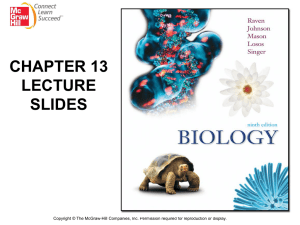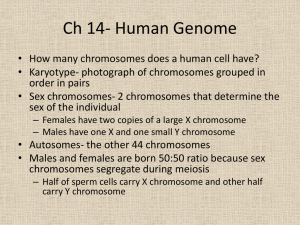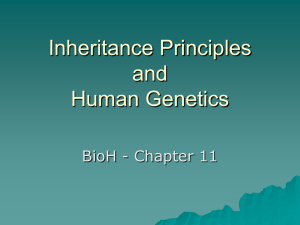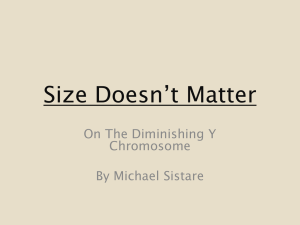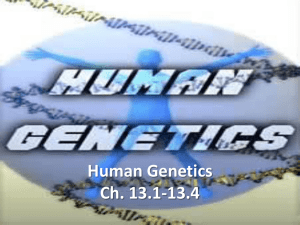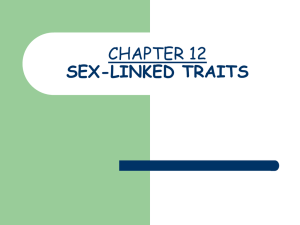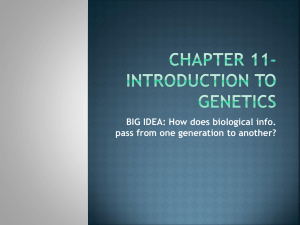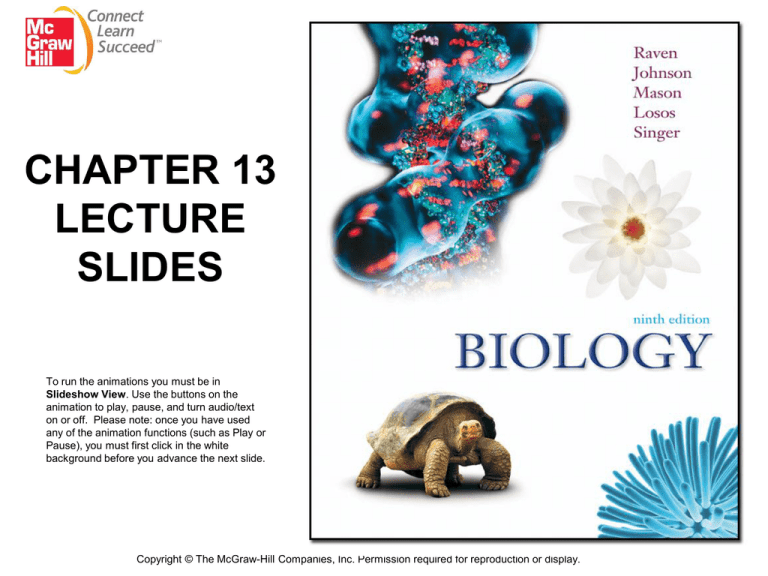
CHAPTER 13
LECTURE
SLIDES
To run the animations you must be in
Slideshow View. Use the buttons on the
animation to play, pause, and turn audio/text
on or off. Please note: once you have used
any of the animation functions (such as Play or
Pause), you must first click in the white
background before you advance the next slide.
Copyright © The McGraw-Hill Companies, Inc. Permission required for reproduction or display.
Chromosomes, Mapping, and the
Meiosis–Inheritance Connection
Chapter 13
What Carried Mendel’s
“Factors”?
• Carl Correns – 1900
– First suggests central role for chromosomes
– One of papers announcing rediscovery of
Mendel’s work
• Walter Sutton – 1902
• Chromosomal theory of inheritance
– Based on observations that similar
chromosomes paired with one another during
meiosis
3
• T.H. Morgan – 1910
– Working with fruit fly, Drosophila melanogaster
– Discovered a mutant male fly with white eyes instead
of red
– Crossed the mutant male to a normal red-eyed
female
• All F1 progeny red eyed = dominant trait
4
• Morgan crossed F1 females x F1 males
• F2 generation contained red and whiteeyed flies
– But all white-eyed flies were male
• Testcross of a F1 female with a white-eyed
male showed the viability of white-eyed
females
• Morgan concluded that the eye color gene
resides on the X chromosome
• FIRST DIRECT EVIDENCE FOR
CHROMOSOMAL THEORY OF
INHERITANCE! – showed that genes lie
5
on chromosomes
6
7
Sex Chromosomes
• Sex determination in Drosophila is based on the
number of X chromosomes
– 2 X chromosomes = female
– 1 X and 1 Y chromosome = male
• Sex determination in humans is based on the
presence of a Y chromosome
– 2 X chromosomes = female
– Having a Y chromosome (XY) = male
8
Copyright © The McGraw-Hill Companies, Inc. Permission required for reproduction or display.
X chromosome
Y chromosome
2.8 µm
© BioPhoto Associates/Photo Researchers, Inc.
• Humans have 46 total chromosomes
– 22 pairs are autosomes
– 1 pair of sex chromosomes
– Y chromosome highly condensed
• Recessive alleles on male’s X have no active
counterpart on Y
– “Default” for humans is female
• Requires SRY gene on Y for “maleness”
9
Hemophilia
• Disease that affects a single protein in a
cascade of proteins involved in the formation of
blood clots
• Form of hemophilia is caused by an X-linked
recessive allele
– Heterozygous females are asymptomatic carriers
• Allele for hemophilia was introduced into a
number of different European royal families by
Queen Victoria of England
10
11
Dosage compensation
• Ensures an equal expression of genes
from the sex chromosomes even though
females have 2 X chromosomes and
males have only 1
• In each female cell, 1 X chromosome is
inactivated and is highly condensed into a
Barr body
• Females heterozygous for genes on the X
chromosome are genetic mosaics
12
13
Please note that due to differing
operating systems, some animations
will not appear until the presentation is
viewed in Presentation Mode (Slide
Show view). You may see blank slides
in the “Normal” or “Slide Sorter” views.
All animations will appear after viewing
in Presentation Mode and playing each
animation. Most animations will require
the latest version of the Flash Player,
which is available at
http://get.adobe.com/flashplayer.
14
Chromosome theory exceptions
• Mitochondria and chloroplasts contain genes
• Traits controlled by these genes do not follow
the chromosomal theory of inheritance
• Genes from mitochondria and chloroplasts are
often passed to the offspring by only one parent
(mother)
– Maternal inheritance
• In plants, the chloroplasts are often inherited
from the mother, although this is species
dependent
15
Genetic Mapping
• Early geneticists realized that they could
obtain information about the distance
between genes on a chromosome
• Based on genetic recombination (crossing
over) between genes
• If crossover occurs, parental alleles are
recombined producing recombinant
gametes
16
17
18
Review of Expectations –
2
genes
on
same
chromosome
R - Round, r-oval
W-White, w-black
P1
RRWW x rrww
F1
RrWw
F2 - testcross
rw
F2 Expected if
Same
Chromosome
RW
RrWw
rw
rrww
1
1
Round_White oval_black
19
Review of Expectations2
genes
on
diff.
chromosomes
R - Round, r-oval
W-White, w-black
P1
RRWW x rrww
F1
RrWw
F2 - testcross
rw
F2 Expected if
Indep. Asst.
RW
RrWw
Rw
Rrww
1
Round_White Round_black
rW
rrWw
1
rw
rrww
1
1
oval_White oval_black
20
Review of Expectations2 genes on same chromosome – but now with
crossover events
R - Round, r-oval
W-White, w-black
P1
RRWW x rrww
F1
RrWw
F2 - testcross
rw
F2 Expected if
Crossover
between genes
RW
RrWw
Rw
Rrww
rW
rrWw
<1
<<1
Round_White Round_black
rw
rrww
<<1
<1
oval_White oval_black
RECOMBINANTS
21
• Alfred Sturtevant
– Undergraduate in T.H. Morgan’s lab
– Put Morgan’s observation that recombinant
progeny reflected relevant location of genes in
quantitative terms
– As physical distance on a chromosome
increases, so does the probability of
recombination (crossover) occurring between
the gene loci
22
Probability of crossover
depends on distance
C
S
C
c
S
s
c
s
23
Recombination Frequency
CS
Appearance
(phenotype)
if Independent
Assortment
if closely linked (no
crossover)
if there's some
distance between
them
if there's more
distance between
them
if there's even more
distance between
them
if there's even more
distance between
them
Now they're so far
apart they almost sort
independently due to
the high probability of
crossover events
Genotype of gametes formed by double
heterozygous parent (Cc Ss)
cs
Cs
cS
CcSs
Colored,
Smooth
ccss
colorless,
wrinkled
Ccss
Colored,
wrinkled
25%
25%
50%
50%--
45%
40%
35%
30%
25%
45%
40%
35%
30%
25%
ccSs
colorless,
Smooth
25%
% total
recombinants
25%
--
5%
10%
15%
20%
25%
50%
0%
5%
10%
15%
20%
25%
10%
20%
30%
40%
50%
C
c
S
s
C
S
cs
C
S
c
s
C
S
c
s
C
S
C
c
s
S
s
C
c
S
s
c
24
Multiple crossovers
• If homologues undergo two crossovers
between loci, then the parental
combination is restored
• Leads to an underestimate of the true
genetic distance
• Relationship between true distance on a
chromosome and the recombination
frequency is not linear
25
26
Working examples- note the cute
way to cross to test for linkage
• 1. In tomatoes tall growth habit is the result of a dominant gene, D,
dwarf growth to its recessive allele, d. Smooth epidermis is due to a
dominant gene, P, pubescent epidermis to its recessive allele, p. A
homozygous tall smooth variety was crossed with a dwarf pubescent
variety. The F1 were test crossed to dwarf pubescent. The results of
the test cross were as follows:
•
• tall, smooth - 96
• tall, pubescent - 4
• dwarf, smooth - 3
• dwarf, pubescent - 95
•
• Are these genes linked (on the same chromosome)? If so, what is
the percent of crossing over?
27
Worked solution
P1 == DDPP x ddpp
F1 == DdPp
TestCross
dp
Parental
gametes
DP and dp
DP
Dp
dP
dp
DdPp
Ddpp
ddPp
ddpp
Tall, smooth Tall, pubes dwarf, smooth dwarf, pubes
96
4
3
95
Same Chromosome because mostly parental types
% Crossover = (4+3) / (96+4+3+95)
"="
7recombinants
198total offspring
3.535353535% crossover
28
• 2. In rabbits color is due to a dominant gene, D,
albinism to its recessive allele, d. Black is the
result of a dominant gene, B, brown to its
recessive allele, b. Brown (homozygous) rabbits
are crossed with albinos carrying black in the
homozygous state. The F1 are crossed to
double recessive. From many such crosses the
total results are:
•
• black - 68
• brown - 132
• albino - 200
•
29
• Are these genes linked?
Worked solution
P1 == DDbb x ddBB
F1 == DdBb
Parental
gametes
Db and dB
TestCross
db
Db
DB
db
dB
Ddbb
DdBb
ddbb
ddBb
Colored, brn Colored, blk Albino, brown
Albino, black
132
68
?
?
200 albinos=
68+132
Same Chromosome because mostly parental types
% Crossover = (68+68?) / (132+68+(68+132) )
"="
136recombinants
400total offspring
34% crossover
30
• In corn purple plant color is due to a dominant gene, P,
green plant color to recessive allele, p. Normal leaves
are due to a dominant gene, N, narrow leaves to its
recessive allele, n. Homozygous green plants with
homozygous normal leaves were crossed with
homozygous purple plants having narrow leaves. The F1
were crossed with green plants with narrow leaves. The
results of this test cross were as follows:
•
• purple plants with normal leaves - 197
• purple plants with narrow leaves - 201
• green plants with normal leaves - 199
• green plants with narrow leaves - 203
•
• Are these genes linked? If so what is the percent cross
31
over?
Worked solution-note that
parental gametes are mixed
P1 == ppNN x PPnn
F1 == pPNn
TestCross
pn
Parental
gametes
pN and Pn
pN
pn
PN
Pn
ppNn
ppnn
PpNn
Ppnn
green, norm Grn, narrow Purple, norm
Purp, narrow
199
203
197
201
Different Chromosomes because equal probabilities
32
• In corn tallness is due to a dominant gene, D, dwarfness
to its recessive allele, d. Normal leaves is dominant, N,
crinkly leaves is recessive, n. Homozygous tall, crinklyleaved corn was crossed to dwarf, homozygous normalleaved corn. The F1 which was tall normal leaved, was
crossed to double-recessive dwarf crinkly-leaved corn.
The results were as follows:
•
•
•
•
Tall crinkly-leaved - 83
Tall, normal-leaved - 19
dwarf crinkly-leaved - 17
dwarf normal-leaved - 81
• Are these two pairs of genes linked? If so, what is the
percent crossing over?
33
Worked solution-note that
parental gametes are mixed
P1 == DDnn x ddNN
F1 == DdnN
TestCross
dn
Dn
Ddnn
Tall, crinkly
81
Parental
gametes
Dn and dN
DN
DdNn
Tall, norm
dn
ddnn
dwarf, crinkly
19
dN
ddNn
dwarf, norm
17
83
Same chromosome because mostly parental types
(19+17)/(200) =
36/200=18%
34
Constructing maps
• The distance between genes is proportional
to the frequency of recombination events
recombination
=
frequency
recombinant progeny
total progeny
• 1% recombination = 1 map unit (m.u.)
• 1 map unit = 1 centimorgan (cM)
35
Three-point testcross
• Uses 3 loci instead of 2 to construct maps
• Gene in the middle allows us to see recombination
events on either side
• In any three-point cross, the class of offspring with two
crossovers is the least frequent class
• In practice, geneticists use three-point crosses to
determine the order of genes, then use data from the
closest two-point crosses to determine distances
36
37
Human genome maps
• Data derived from historical pedigrees
• Difficult analysis
– Number of markers was not dense enough for
mapping up to 1980s
– Disease-causing alleles rare
• Situation changed with the development of
anonymous markers
– Detected using molecular techniques
– No detectable phenotype
38
SNPs
•
•
•
•
Single-nucleotide polymorphisms
Affect a single base of a gene locus
Used to increase resolution of mapping
Used in forensic analysis
– Help eliminate or confirm crime suspects or
for paternity testing
39
40
Sickle cell anemia
• First human disease
shown to be the result
of a mutation in a
protein
• Caused by a defect in
the oxygen carrier
molecule, hemoglobin
– Leads to impaired
oxygen delivery to
tissues
41
• Homozygotes for sickle cell allele exhibit
intermittent illness and reduced life span
• Heterozygotes appear normal
– Do have hemoglobin with reduced ability
• Sickle cell allele is particularly prevalent in
people of African descent
– Proportion of heterozygotes higher than expected
– Confers resistance to blood-borne parasite that
causes malaria
42
Nondisjunction
• Failure of homologues or sister chromatids
to separate properly during meiosis
• Aneuploidy – gain or loss of a
chromosome
– Monosomy – loss
– Trisomy – gain
– In all but a few cases, do not survive
43
• Smallest autosomes can present as 3
copies and allow individual to survive
– 13, 15, 18, 21 and 22
– 13, 15, 18 – severe defects, die within a few
months
– 21 and 22 – can survive to adulthood
– Down Syndrome – trisomy 21
• May be a full, third 21st chromosome
• May be a translocation of a part of chromosome 21
• Mother’s age influences risk
44
45
Nondisjunction of sex chromosomes
• Do not generally experience severe
developmental abnormalities
• Individuals have somewhat abnormal features,
but often reach maturity and in some cases may
be fertile
• XXX – triple-X females
• XXY – males (Klinefelter syndrome)
• XO – females (Turner syndrome)
• OY – nonviable zygotes
• XYY – males (Jacob syndrome)
46
47
Genomic imprinting
• Phenotype exhibited by a particular allele
depends on which parent contributed the
allele to the offspring
• Specific partial deletion of chromosome 15
results in
– Prader-Willi syndrome if the chromosome is
from the father
– Angelman syndrome if it’s from the mother
48
Detection
• Pedigree analysis used to determine the
probability of genetic disorders in the
offspring
• Amniocentesis collects fetal cells from the
amniotic fluid for examination
• Chorionic villi sampling collects cells from
the placenta for examination
49
50
51

